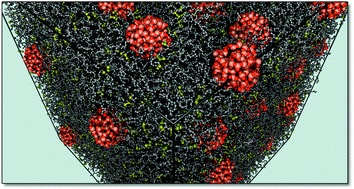Filler reinforcement in cross-linked elastomer nanocomposites: insights from fully atomistic molecular dynamics simulation
Abstract
Using a fully atomistic model, we perform large-scale molecular dynamics simulations of sulfur-cured polybutadiene (PB) and nanosilica-filled PB composites. A well-integrated network without sol fraction is built dynamically by cross-linking the coarse-grained precursor chains in the presence of embedded silica nanoparticles. Initial configurations for subsequent atomistic simulations are obtained by reverse mapping of the well-equilibrated coarse-grained systems. Based on the concept of “maximally inflated knot” introduced by Grosberg et al., we show that the networks simulated in this study behave as mechanically isotropic systems. Analysis of the network topology in terms of graph theory reveals that mechanically inactive tree-like structures are the dominant structural components of the weakly cross-linked elastomer, while cycles are mainly responsible for the transmission of mechanical forces through the network. We demonstrate that quantities such as the system density, thermal expansion coefficient, glass transition temperature and initial Young's modulus can be predicted in qualitative and sometimes even in quantitative agreement with experiments. The nano-filled system demonstrates a notable increase in the glass transition temperature and an approximately two-fold increase in the nearly equilibrium value of elastic modulus relative to the unfilled elastomer even at relatively small amounts of filler particles. We also examine the structural rearrangement of the nanocomposite subjected to tensile deformation. Under high strain-rate loading, the formation of structural defects (microcavities) within the polymer bulk is observed. The nucleation and growth of cavities in the post-yielding strain hardening regime mainly take place at the elastomer/nanoparticle interfaces. As a result, the cavities are concentrated just near the embedded nanoparticles. Therefore, while the silica nanofiller increases the elastic modulus of the elastomer, it also creates a more defective structure of higher energy in comparison with the unfilled network.


 Please wait while we load your content...
Please wait while we load your content...